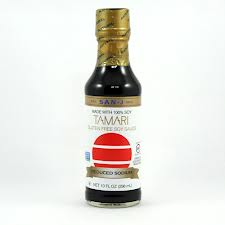
Ever prepare a recipe that you know in advance is going to taste amazing because it has the perfect combination of ingredients, including all the right spices and seasonings, yet once it’s done, after all the preparation and anticipation, it comes up short? It could be that all that work hasn’t gone to waste and that it just needs something to make it “pop”. Next time try some tamari!
Produced mainly in Chūbu region of Japan, tamari is very similar to soy sauce in that it, too, is made from fermented soybeans. Tamari differs from traditional soy sauce in that whereas most soy sauces are approximately 50/50 soybeans/wheat, tamari is made from soybeans with only a touch of wheat or no wheat at all (gluten-free). The result is a thicker, richer, sauce with a smoother, more complex flavor than traditional soy sauce.
Regular tamari has a little more sodium than traditional soy sauce: 320 mg sodium per teaspoon for tamari vs. 291 mg sodium per teaspoon for soy sauce.
San-J gluten-free reduced sodium tamari only has only 237 mg sodium per teaspoon. Compare that to ~600 mg sodium in only a quarter teaspoon of salt!*
Tamari is excellent in stir fry dishes, noodle sauces, dipping sauces, marinades, sauces, soups, casseroles, gravies, or on its own as a condiment. Tamari is a great salt substitute and natural flavor enhancer and heightens flavor of any dish. So next time you need something to make the flavors “pop”, try some tamari!
Resources
*Sodium in regular tamari and traditional soy sauce were looked up in the National Nutritional Database (http://ndb.nal.usda.gov/ndb/search/list); sodium in gluten-free reduced sodium tamari came from the San-J label; sodium in salt was calculated from the mass of one teaspoon of salt (6 grams) and the atomic masses of sodium (23 amu) and chlorine (35 amu).
Produced mainly in Chūbu region of Japan, tamari is very similar to soy sauce in that it, too, is made from fermented soybeans. Tamari differs from traditional soy sauce in that whereas most soy sauces are approximately 50/50 soybeans/wheat, tamari is made from soybeans with only a touch of wheat or no wheat at all (gluten-free). The result is a thicker, richer, sauce with a smoother, more complex flavor than traditional soy sauce.
Regular tamari has a little more sodium than traditional soy sauce: 320 mg sodium per teaspoon for tamari vs. 291 mg sodium per teaspoon for soy sauce.
San-J gluten-free reduced sodium tamari only has only 237 mg sodium per teaspoon. Compare that to ~600 mg sodium in only a quarter teaspoon of salt!*
Tamari is excellent in stir fry dishes, noodle sauces, dipping sauces, marinades, sauces, soups, casseroles, gravies, or on its own as a condiment. Tamari is a great salt substitute and natural flavor enhancer and heightens flavor of any dish. So next time you need something to make the flavors “pop”, try some tamari!
Resources
- http://www.thekitchn.com/ingredient-spotlight-tamari-174139
- http://ideas.thenest.com/dinner-recipes/cooking-advice/qa/cooking-q-a-tamari-vs-soy-sauce.aspx
- http://www.san-j.com/tamari.asp
- http://en.wikipedia.org/wiki/Tamari
- http://cooking.stackexchange.com/questions/12748/whats-the-difference-between-tamari-and-soy-sauce
*Sodium in regular tamari and traditional soy sauce were looked up in the National Nutritional Database (http://ndb.nal.usda.gov/ndb/search/list); sodium in gluten-free reduced sodium tamari came from the San-J label; sodium in salt was calculated from the mass of one teaspoon of salt (6 grams) and the atomic masses of sodium (23 amu) and chlorine (35 amu).



 RSS Feed
RSS Feed